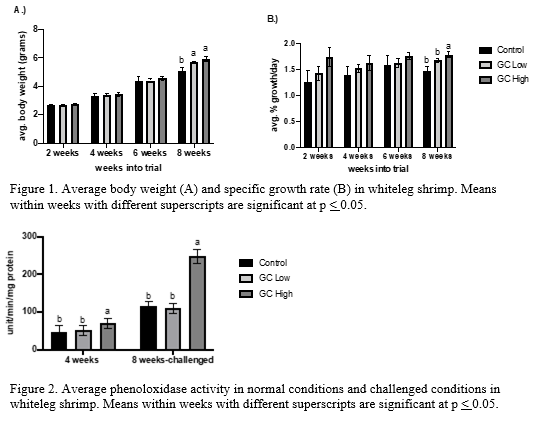APPLICATION OF GARLIC AND CINNAMON COMPOUNDS ON GROWTH PERFORMANCE AND IMMUNE PARAMETERS OF WHITELEG SHRIMP Litopenaeus vannamei
Introduction
As the demand for eco-friendly farming practices and products in aquaculture continues, the industry has shifted to focus on improved maintenance of fish and shrimp health to enhance performance. This focus on the development of novel additives are increasingly applied in aquaculture, including plant-based products, phytogenic feed additives (PFA) . A common usage of PFA’s is to decrease bacterial pressure of pathogens including Vibrio parahaemolyticus and improve growth performance during challenge. This can be achieved because PFA’s , specifically garlic and cinnamon, contain several bioactive molecules that can exert multiple effects on the gastrointestinal (GI) tract . This includes an a ntimicrobial effect by disrupting the cellular membrane of pathogens and the enhancement of the host immunity which aid in anti-inflammatory and antioxidant reactions results in the redirection of energy to maintain performance. The application rate of garlic and cinnamon can be a challenge in aquaculture as therapeutic concentrations during a bacterial challenge can be different for animals in healthy conditions. Therefore, the objective of the experiment was to 1) evaluate the efficacy of a blend of garlic and cinnamon in whiteleg shrimp (Litopenaeus vannamei ) based on growth performance and immunity and 2) i nvestigate immunity and growth changes after a V. parahaemolyticus challenge.
Materials and Methods
A total of 300 juvenile whiteleg shrimp (2.21 + 0.06 g) were placed in one of the following three treatments: Control- basal diet with 1000 ppm of calcium carbonate as a placebo; GC Low – basal diet with 500 ppm of garlic and cinnamon blend (Excential Alliin Plus; Orffa Additives B.V.) and 500 ppm calcium carbonate and; GC High –basal diet with 1000 ppm of garlic and cinnamon blend. The experiment was carried out in 15 aquariums as a complete randomized design (n=5) with each of 240 L capacity that contained 120 L of 15 ppt saline water. The j uvenile whiteleg shrimp were stocked at a density of 150 shrimp/m3 (20 individual/aquarium). Water in each of the aquariums were changed 20% every three days. Aeration was applied into all experimental unit for maintaining DO > 5 mg/L in a semi-closed system. Feed were presented in pelleted form and placed in the aquariums three times a day at 2.5-3 .0 % of cumulative body weight for eight weeks. One hour after feeding, remaining feed was removed to calculate feed intake. Growth performance including weight gain, specific growth rate, feed conversion ratio (FCR) and mortality were measured . Shrimp health and immune status was determined in normal/healthy conditions four weeks into the experiment by total hemocyte count, hemolymph protein and phenoloxidase activity. At eight weeks, each of the shrimp were challenged via injection with V. parahaemolyticus. Twelve hours later, each of the immune parameters from 4-weeks were repeated in addition to the record of the activities of lysozyme, super oxide dismutase and glutathione peroxidase .
Results and Discussion
The inclusion of garlic and cinnamon regardless of dosage resulted in an increased body weight gain by 20.9 % in GC Low and 30.0 % in GC High at the final week of the trial (p < 0.05) relative to the control group (Figure 1A) which also is represented in the increased specific growth rate difference in GC High (Figure 1 B). While feed intake did not significantly change during the trial , the FCR lowered every collection point but became significant (p < 0.05) at 8 weeks with a 30-point and 39-point decrease in GC Low and GC High compared to the control , respectively (Control = 1.524 ; GC Low = 1.272; GC High = 1.183 ). The significant reduced FCR and weight gain may be attributed to the improved immune status of the GC High treatment at the time of the Vibrio challenge. Figure 2 shows that phenoloxidase activity before challenge at 4 weeks resulted in GC High having elevated activity which can act as defense enzymes against invading pathogens. Once the bacterial challenge occurred, there was an overall elevation (p < 0.05) between times of collection but only the GC High was significantly elevated among treatments. Lysozyme activity was also elevated in GC High (610 ± 148.44 unit/mL) relative to both GC Low (323.33 ± 73.11 unit/mL) and Control (226.67 ± 40.96 unit/mL).
Conclusions
Phytogenic feed additive garlic and cinnamon blend can create an environment within the host to maintain and improve weight gain and feed efficiency. However, an elevated dose at 1000 ppm can enhance innate host immunity during bacterial challenge effectively and maintain elevated weight gain during production.
